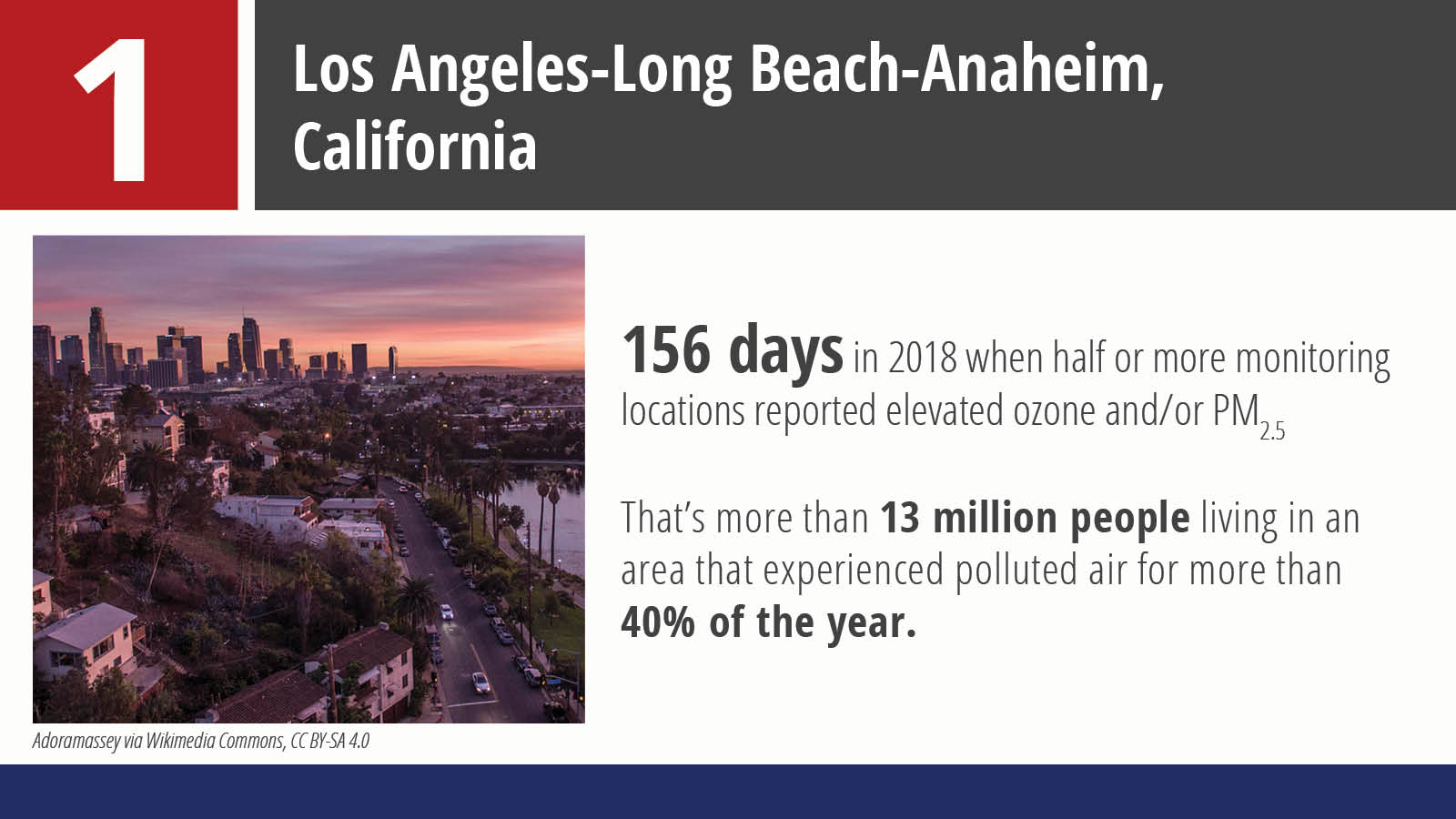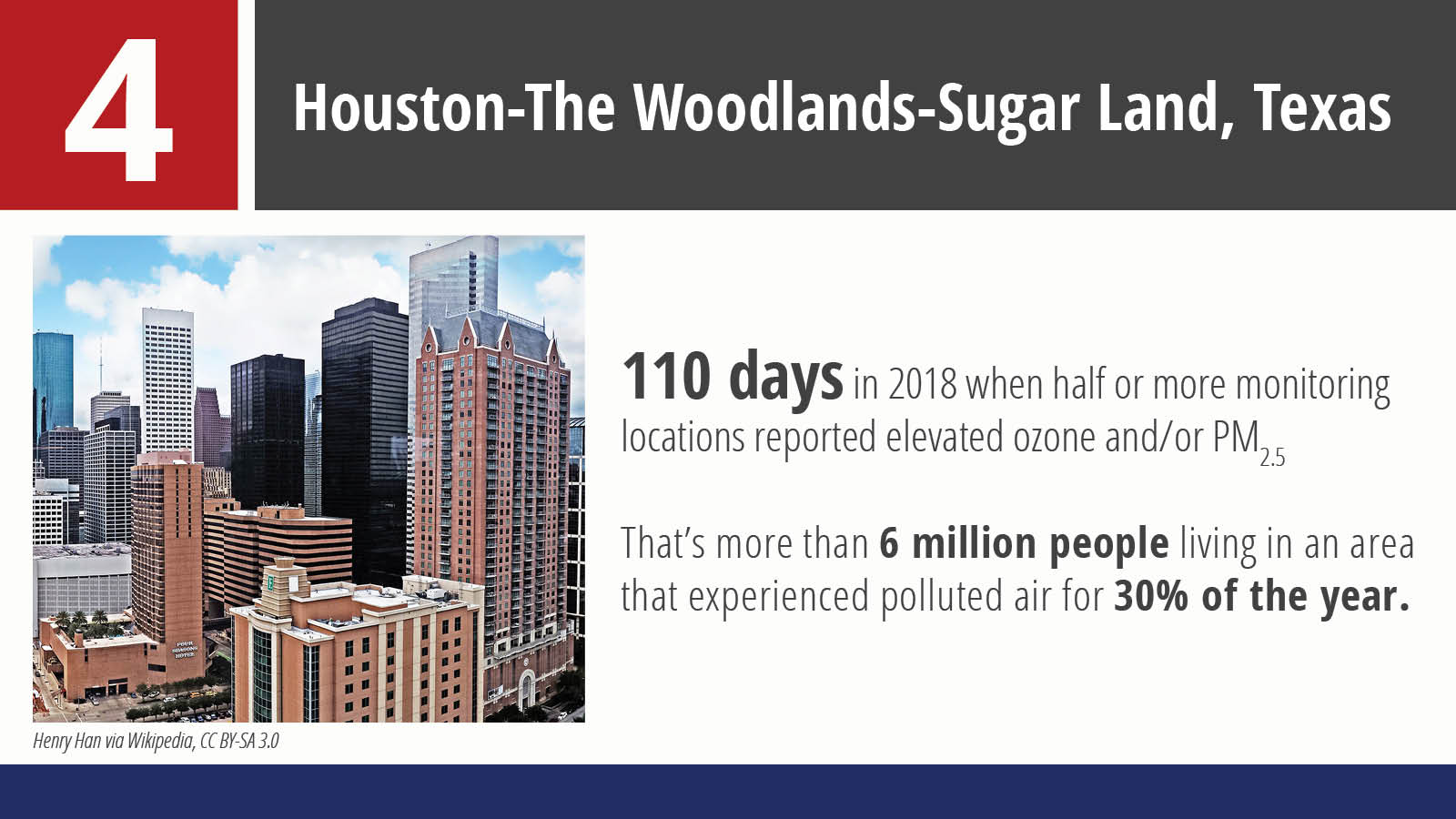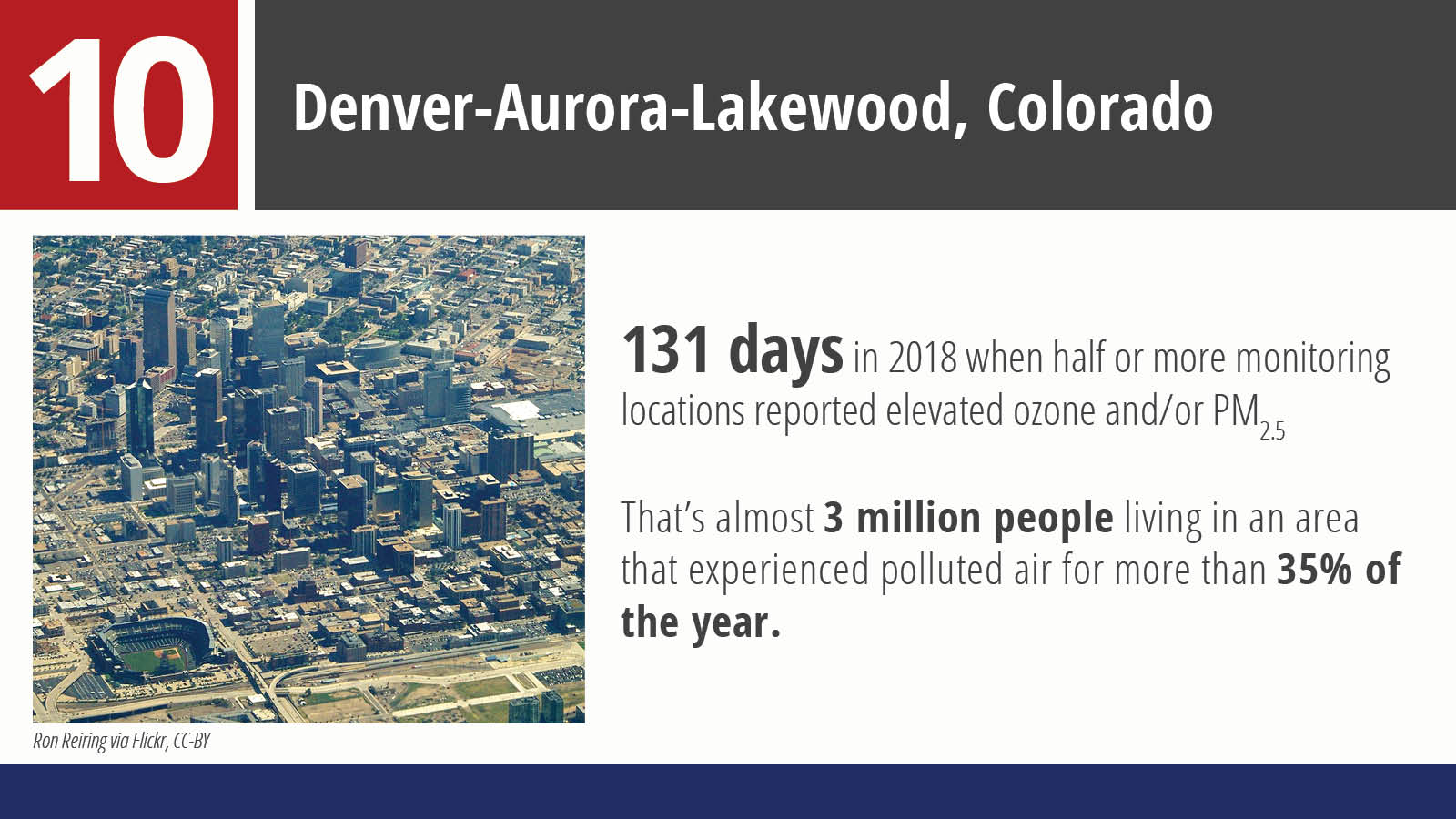
Trouble in the Air
Millions of Americans Breathed Polluted Air in 2018
Millions of Americans Breathed Polluted Air in 2018

We should all be able to breathe clean air. It’s true that the days of thick smog making it difficult to see the mountains in the distance, or even see a building clearly a few blocks away are largely behind us. But people across America still regularly breathe dirty air that increases their risk of premature death and can trigger asthma and other adverse health effects.
Our report shows that the air in your community is probably not as clean as you might think. In 2018, 108 million Americans lived in areas that experienced more than 100 days of degraded air quality. That is equal to more than three months of the year in which ground-level ozone (the main ingredient in smog) and/or particulate pollution was above the level that the EPA has determined presents “little to no risk.” These Americans live in 89 large and small urban areas, and in 12 rural counties. Millions more Americans are exposed to damaging levels of air pollution, but less frequently.
Each year, millions of Americans suffer from adverse health impacts linked to air pollution, and tens of thousands have their lives cut short.
• Fine particulate matter from sources such as vehicles and power plants was responsible for an estimated 107,000 premature deaths in the U.S. in 2011.1
• Air pollution is linked to health problems including respiratory illness, heart attack, stroke, cancer and mental health problems. Research continues to reveal new health impacts. For example, maternal exposure to air pollution such as fine particulates (PM2.5) and ozone is associated with a higher risk of low birth weight, pre-term birth and stillbirth.2 For older adults, long-term exposure to particulate pollution has been associated with an increased risk of Alzheimer’s disease and other forms of dementia.3
• Air pollution’s effects are pronounced among vulnerable populations, including children, pregnant women and the elderly. Research has found that children exposed to particulate pollution can suffer from lung development problems and long-term harm to lung function.4
• Levels of air pollution that meet current federal air quality standards can be harmful to health, especially with prolonged exposure. Researchers can detect negative health impacts, such as increased premature deaths, for people exposed to pollution at levels the EPA considers “good” or “moderate.”5 Current federal standards are less stringent than those recommended by the World Health Organization.6 Moreover, the EPA cautions that unusually sensitive people may experience health effects at “moderate” levels. For these reasons, the analysis in this report includes air pollution at or above the level the EPA labels “moderate,” corresponding with a rating yellow or higher in its Air Quality Index.

Global warming will make air pollution worse.
The U.S. Global Change Research Program’s Fourth National Climate Assessment warns that unless the nation acts to improve air quality, “climate change will worsen existing air pollution levels. This worsened air pollution would increase the incidence of adverse respiratory and cardiovascular health effects, including premature death.”7
Climate change will worsen air pollution in several ways, including:
• Rising temperatures will speed up the formation of ozone. According to one study, people in the Northeast, Midwest and Southwest will experience three to nine more days of ozone pollution at or above the level the U.S. EPA considers “unhealthy for sensitive groups” annually by 2050 compared to 2000 because of higher temperatures.8
• Hotter, drier weather will increase the frequency and severity of wildfires, which create particulate pollution, contribute to smog, and can spread air pollution for hundreds of miles.
Millions of Americans live in urban and rural areas that experience frequent ozone and/or particulate pollution.

• 108 million Americans lived in the 89 large and small urban areas and 12 rural counties that experienced more than 100 days of degraded air quality in 2018.
• Another 157 million Americans resided in the 264 large and small urban areas and 61 rural counties that faced 31 to 100 days — a month or more — of elevated ozone and/or particulate pollution. The communities included major urban areas such as the District of Columbia and Miami, and smaller communities such as Racine, Wisconsin, and Columbia, Missouri.
The troubled ten
Most metropolitan areas in the U.S. experience elevated levels of air pollution. Below are the 10 most populated metropolitan areas in the U.S. which experienced more than 100 days of elevated air pollution levels in 2018.
People in every state face health risks from ground-level ozone pollution.
• Thirty-eight urban areas and rural counties, which are home to more than 21 million people, experienced more than 100 days of ozone pollution in 2018. Such frequent ozone pollution affected people living in communities in California, New Mexico, Arizona, Utah, Colorado and Wyoming.
• Residents of another 228 large and small urban areas and rural counties encountered air with elevated levels of ozone pollution on 31 to 100 days in 2018. That means that for one to three months in 2018, up to 170 million Americans were exposed to elevated ozone pollution. Those rural counties and urban areas were located in 45 different states, plus the District of Columbia.
Recommendations
Air pollution already harms the health of millions of Americans around the country, and cuts short tens of thousands of lives each year. Climate change will make it worse. Many solutions that address the climate challenge will also improve air quality. Policymakers at the federal, state and local levels should look to implement policies that:
• Reduce emissions from transportation, the largest source of global warming pollution in the U.S. and a major source of air pollution in many communities.9 Policies to reduce global warming and air pollution include expanded use of zero-emission vehicles, regional programs to cap pollution from transportation, and support for active transportation such as walking and biking.
• Move the country away from fossil fuels — which are a major source of climate pollution in transportation, electricity generation and buildings — and toward the use of clean, renewable energy such as wind turbines and solar panels.
• Strengthen, and strongly enforce, emission and air quality standards to fully protect human health.
Sources
- Andrew Goodkind et al., “Fine-Scale Damage Estimates of Particulate Matter Air Pollution Reveal Opportunities for Location-specific Mitigation of Emissions,” PNAS, DOI: 10.1073/pnas.1816102116, 30 April 2019, available at https://www.pnas.org/content/116/18/8775.
- Low birth weight: E. Coker et al., “Modeling Spatial Effects of PM(2.5) on Term Low Birth Weight in Los Angeles County,” Environmental Research, 142:354-64, doi: 10.1016/j.envres.2015.06.044, 18 July 2015, and O. Laurent et al., “Investigating the Association between Birth Weight and Complementary Air Pollution Metrics: a Cohort Study,” Environmental Health, 12:18, doi: 10.1186/1476-069X-12-18, 17 February 2013. Pre-term birth: J. Zhu et al., “Exposure to Ambient PM(2.5) During Pregnancy and Preterm Birth in Metropolitan Areas of the State of Georgia,” Environmental Science and Pollution Research, 26(3):2492-2500, doi: 10.1007/s11356-018-3746-8, 24 November 2018, and O. Laurent O et al., “A Statewide Nested Case-control Study of Preterm Birth and Air Pollution by Source and Composition: California, 2001-2008,” Environmental Health Perspectives, 124(9):1479-86, doi: 10.1289/ehp.1510133, 19 February 2016. Stillbirth: P. Mendola et al., “Chronic and Acute Ozone Exposure in the Week Prior to Delivery Is Associated with the Risk of Stillbirth,” International Journal of Environmental Research and Public Health, 14(7): E731, doi: 10.3390/ijerph14070731, 6 July 2017, and Emily DeFranco et al., “Air Pollution and Stillbirth Risk: Exposure to Airborne Particulate Matter during Pregnancy Is Associated with Fetal Death,” PLoS One, 10(3), doi: 10.1371/journal.pone.0120594, 20 March 2015.
- Kelly Bishop et al., The National Bureau of Economic Research, Hazed and Confused: The Effect of Air Pollution on Dementia, DOI: 10.3386/w24970, revised August 2019, available at https://www.nber.org/papers/w24970.
- Ki-Hyun Kim et al., “A Review on the Human Health Impact of Airborne Particulate Matter,” Environment International, January 2015, DOI:10.1016/j.envint.2014.10.005, available at https://www.sciencedirect.com/science/article/pii/S0160412014002992, p. 138.
- Michelle L. Bell, Roger D. Peng and Francesca Dominici, “The Exposure-Response Curve for Ozone and Risk of Mortality and the Adequacy of Current Ozone Regulations,” Environmental Health Perspectives, 114(4): 532-6, April 2006, DOI:10.1289/ehp.8816.
- World Health Organization, WHO Air Quality Guidelines for Particulate Matter, Ozone, Nitrogen Dioxide and Sulfur Dioxide, Global Update 2005, Summary of Risk Assessment, 2006, archived at https://web.archive.org/web/20180430002838/http://apps.who.int/iris/bits…. The WHO’s 8-hour standard for ozone is 100 µg/m3, which is equal to 51 ppb, per Bob Weinhold, “Ozone Nation EPA Standard Panned by the People,” Environmental Health Perspectives, 116(7):A303-A305, July 2008, available at https://www.ncbi.nlm.nih.gov/pmc/articles/PMC2453178/pdf/ehp0116-a00302.pdf. The current federal 8-hour ozone standard is 70 ppb, per U.S. Environmental Protection Agency, The National Ambient Air Quality Standards: Updates to the Air Quality Index (AQI) for Ozone and Ozone Monitoring Requirements, 1 October 2015, available at https://www.epa.gov/sites/production/files/2015-10/documents/20151001_ai….
- Christopher Nolte et al., U.S. Global Change Research Program, Impacts, Risks, and Adaptation in the United States: Fourth National Climate Assessment, Volume II, Chapter 13: Air Quality, 2018, available at https://nca2018.globalchange.gov/downloads/NCA4_Ch13_Air-Quality_Full.pdf.
- L. Shen, L.J. Mickley and E. Gilleland, “Impact of Increasing Heat Waves on U.S. Ozone Episodes in the 2050s: Results from a Multimodel Analysis Using Extreme Value Theory,” Geophysical Research Letters, 43:4017-4025, 25 April 2016, doi:10.1002/2016GL068432, p. 4023. The study looks at ozone above 75 ppb, which is in the range the EPA considers “unhealthy for sensitive groups,” per U.S. Environmental Protection Agency, The National Ambient Air Quality Standards: Updates to the Air Quality Index (AQI) for Ozone and Ozone Monitoring Requirements, 1 October 2015, available at https://www.epa.gov/sites/production/files/2015-10/documents/20151001_ai….
- Largest source of global warming pollution: U.S. Environmental Protection Agency, Sources of Greenhouse Gas Emissions, 2017, accessed 29 November 2019, archived at https://web.archive.org/web/20191122230241/https://www.epa.gov/ghgemissi….
Topics
Find Out More


Recording of Road to 100% Renewable Energy with Dr. Mark Jacobson

The Biden administration has released $1 billion in funding for urban trees. Here’s why that matters.












